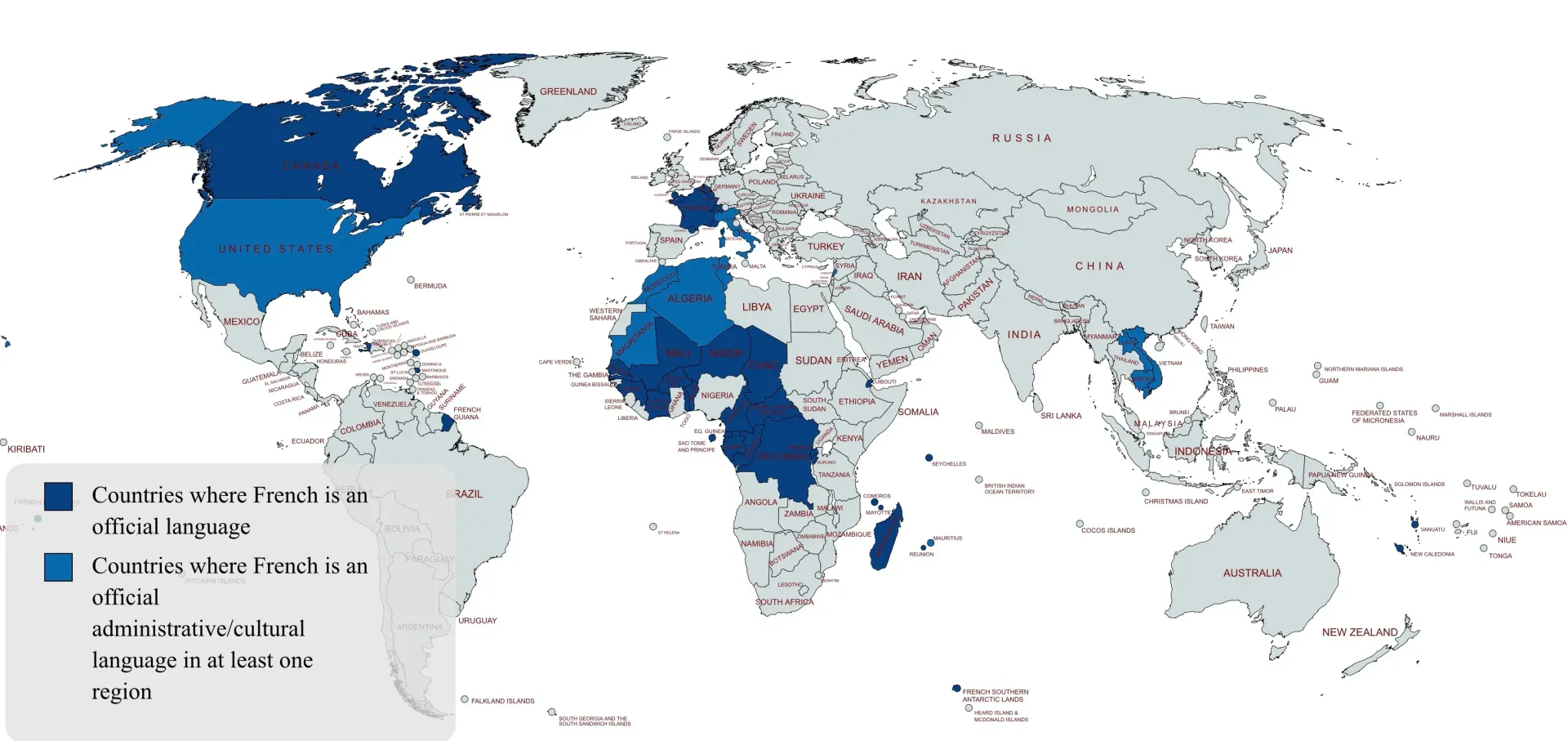
The Global Reach of the French Language: Insights and Opportunities
French is often celebrated for its beauty and complexity, but it is also a language of significant global importance. Understanding the French speaking world map is essential for grasping the cultural, economic, and social impact of this language. This article will explore the global distribution of French, the vibrant voice over market in French-speaking regions, and the various opportunities that arise from this linguistic landscape. Approximately 300 million people speak French worldwide. This figure includes native speakers as well as those who use French as a second language. The language continues to grow, particularly in Africa, where the number of French speakers is increasing rapidly.
The French Speaking World Map
French is an official language in 29 countries and is spoken across multiple continents, showcasing its global appeal. According to the article "5 Maps that Show how French is Truly a Global Language" by Bradley Gearhart, French is not only dominant in Europe but also expanding rapidly in Africa and present in stable communities in North America, the Caribbean, and parts of the Pacific and Indian Oceans.
Key Statistics of French Speakers
- France: Over 65 million speakers
- Canada: Between 10 and 15 million speakers
- Algeria: Between 25 and 30 million speakers
- Democratic Republic of the Congo: Between 40 and 45 million speakers
- Madagascar: Between 5 and 10 million speakers
- Cameroon: Between 10 and 15 million speakers
- Ivory Coast: Approximately 20 million speakers
- Senegal: Around 14 million speakers
- Belgium: About 4.5 million speakers
- Switzerland: Approximately 1.5 million speakers
These statistics highlight the widespread use of French and its growing influence in various regions, particularly in Africa.
The Growing Presence in Africa
The African continent is home to the largest French-speaking population in the world. As highlighted in Gearhart's article, French is a growing language in Africa, with countries like Mali, Burkina Faso, and Cameroon witnessing an increase in French speakers. This growth is fueled by urbanization, educational initiatives, and economic development, creating a robust demand for voice over services in various sectors, including e-learning, media, and advertising.
1. Countries with French as an Official Language
Countries such as France, Belgium, Switzerland, and Canada exemplify the stronghold of French in Europe. In Africa, nations like the Democratic Republic of Congo, Ivory Coast, and Senegal have a significant number of French speakers. This widespread use of French establishes a vast audience for content, including voice over services, making it a lucrative market for professionals.
2. North America and the Caribbean
In North America, French is one of the official languages of Canada, particularly in Quebec, where a vibrant French-speaking culture thrives. The Caribbean also has various French-speaking territories, such as Martinique and Guadeloupe. The voice over market in these regions is notable, as businesses and educational institutions seek high-quality French content for their audiences.
The Voice Over Market in French-Speaking Countries
As the demand for French language content grows, so does the voice over market. Here are some key factors driving this expansion:
1. Cultural Relevance and Localization
In today's globalized economy, businesses must resonate with local cultures to succeed. The voice over industry plays a crucial role in this localization process. Professional voice actors can adapt their performances to reflect the cultural nuances of their audience, ensuring that the message is not just heard but felt. This is particularly important in French-speaking regions, where cultural identity is deeply intertwined with language.
2. Diverse Applications of Voice Over Services
The applications for voice over in French-speaking countries are extensive. From corporate training and e-learning to advertising and entertainment, the demand for skilled voice actors is on the rise. As companies expand into French-speaking markets, they require localized voice over content that aligns with their branding and messaging.
3. Technological Advancements
Advancements in technology have made it easier for voice actors to work remotely and collaborate with clients worldwide. This has opened up the market for voice over services in French-speaking regions, allowing talent from various backgrounds to connect with businesses looking for high-quality audio content.
4. Investment in Quality
Organizations are increasingly recognizing the value of professional voice over services. High-quality recordings can significantly impact how a message is received, making it essential for brands to invest in experienced voice talents who understand the intricacies of the French language. This investment not only enhances the effectiveness of communication but also builds trust with the audience.
Top 10 Most Spoken Languages in the World: Estimated Speaker Counts :
- English: Approximately 1.5 billion speakers
- Mandarin Chinese: Around 1.1 billion speakers
- Hindi: About 600 million speakers
- Spanish: Approximately 550 million speakers
- Modern Standard Arabic: About 310 million speakers
- French: Around 300 million speakers
- Portuguese: Around 260 million speakers
- Russian: About 260 million speakers
- Bengali: Approximately 230 million speakers
- Urdu: Approximately 170 million speakers
Challenges in the Voice Over Market
Despite the opportunities, the voice over market in French-speaking countries also faces challenges:
1. Competition from AI and Automation
With advancements in artificial intelligence, there is growing competition from automated voice generation technologies. While these tools can produce quick and cost-effective solutions, they often lack the emotional depth and cultural understanding that a human voice actor can provide. This presents both a challenge and an opportunity for voice talents to differentiate themselves by emphasizing the unique value of their skills.
2. Economic Factors
Economic conditions can influence the demand for voice over services. In regions where budgets are tight, companies may opt for lower-cost solutions, impacting the rates professional voice actors can charge. However, as businesses recognize the importance of quality content, there is potential for growth in the market.
3. Navigating Different Markets
Each French-speaking region has its unique cultural and economic landscape, which can affect voice over pricing and demand. Voice actors must understand these nuances to effectively market their services and adapt their performances accordingly.
Conclusion
The French speaking world map illustrates the extensive reach of the French language and the significant opportunities that exist within this linguistic landscape. As the demand for French content continues to grow, the voice over market in French-speaking regions is poised for expansion. By understanding the cultural context, leveraging technological advancements, and delivering high-quality services, voice actors can thrive in this dynamic environment.
Whether you are a voice over artist looking to break into the French-speaking market or a business seeking to engage with French-speaking audiences, the potential is vast. Embrace the opportunities that come with this global language, and you may find yourself at the forefront of a thriving industry. If you're interested in voice over services or need to explore the market further, feel free to reach out!























